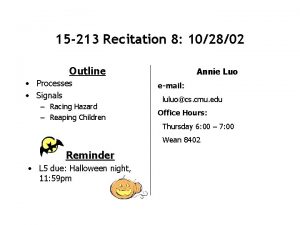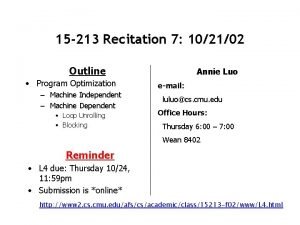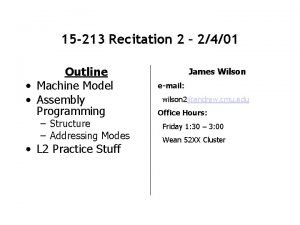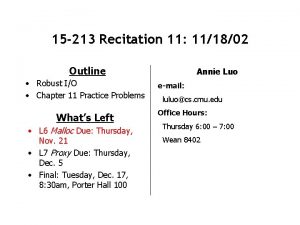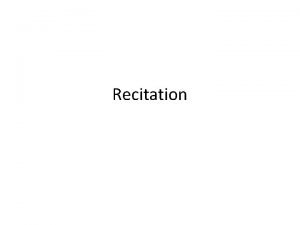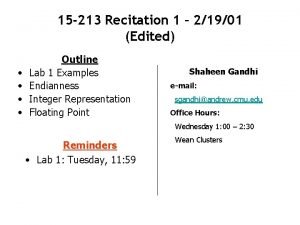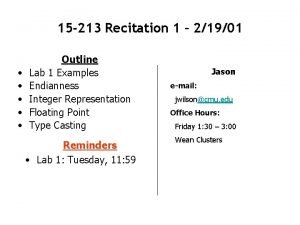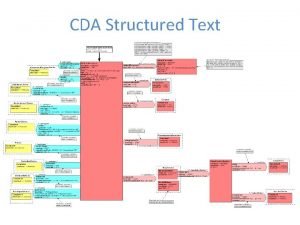15 213 Recitation 5 21901 Outline Structured Data









- Slides: 9

15 -213 Recitation 5 – 2/19/01 Outline • Structured Data: structs / unions • Alignment • Floating Point Reminders • Lab 2: Wednesday, 11: 59 • EXAM 1: Tuesday, 2/27 • UC Mc. Conomy Shaheen Gandhi e-mail: sgandhi@andrew. cmu. edu Office Hours: Wednesday 12: 30 – 2: 30 Wean 3108

structs and unions • Organize data • structs store multiple elements, unions store a single element at a time • Members of a union change how you look at data • unions used for mutually exclusive data

Alignment • • Contiguous areas of memory Each block is aligned – Size is a multiple of a base value – “Base value” is the largest alignment of data types in structure • Why? – Efficient load/store from memory – Virtual Memory paging • This applies to any variable type

Structure of a struct • Find largest alignment – • Size of structure must be a multiple of this For each element e (top to bottom): – Find alignment of e • – – • • Starting offset must be a multiple of this Pad previous element with empty space until alignment matches Allocate alignment worth of space to e Pad last element with empty space until alignment of structure matches Note this isn’t optimal!

Structure of a union • Find largest alignment – • Size of structure must be a multiple of this Allocate this much space struct one { int i; double d; char c[2]; } Examples union two { int i; double d; char c[2]; }

Floating Point (Better known as “I’m going to kill the person that thought this up”) • IEEE Floating Point – – • Floating Point at a bit level: s – – – • • Standard notation Tons of features we won’t look at exp frac s – sign bit (S) exp – exponent (maps to E, has e bits) frac –significand (maps to M, has f bits) Numerical Equivalent: – 1 s M 2 E “Normalized” and “Denormalized” encoding

“Normalized” Encoding • exp 0 and exp 111… 1 – • E = exp – B – – – • B is the “Bias” Usually 2 e-1 – 1, but can be different exp: Unsigned integer value [1, 2 e – 1] M = 1. {frac} – – • If exp = 111… 1, it’s or NAN {frac} are the bits of frac is a fractional binary number Normalized Numbers have range [21 -B, 2 B+1) – And their negatives

“Denormalized” Encoding • • exp = 0 E = -B+1 M = 0. {frac} Denormalized Numbers have Range [0, 21 -B) – Na. N And their negatives -Normalized +Denorm -Denorm 0 +0 +Normalized + Na. N

Examples • 8 bit FP, 1 bit sign, 4 bit exponent, 3 bit significand, Bias of 7 Representation -> Number 0 0101 011 0 0000 101 1 1011 110 0. 34375 0. 009765625 -28. 0
